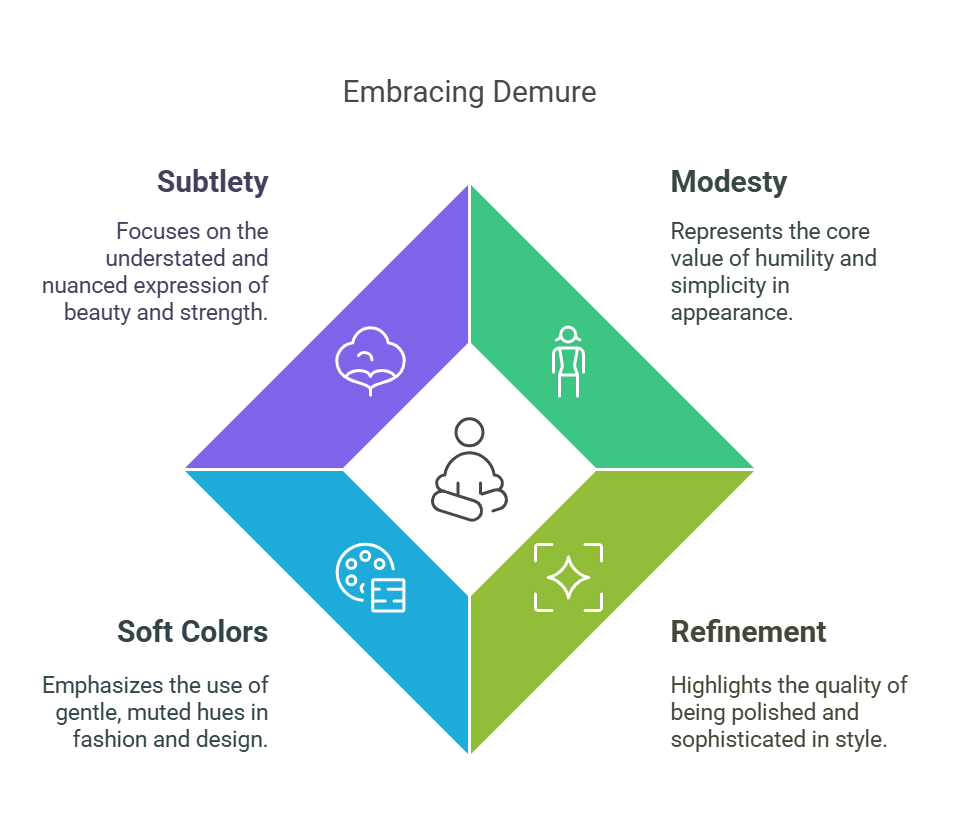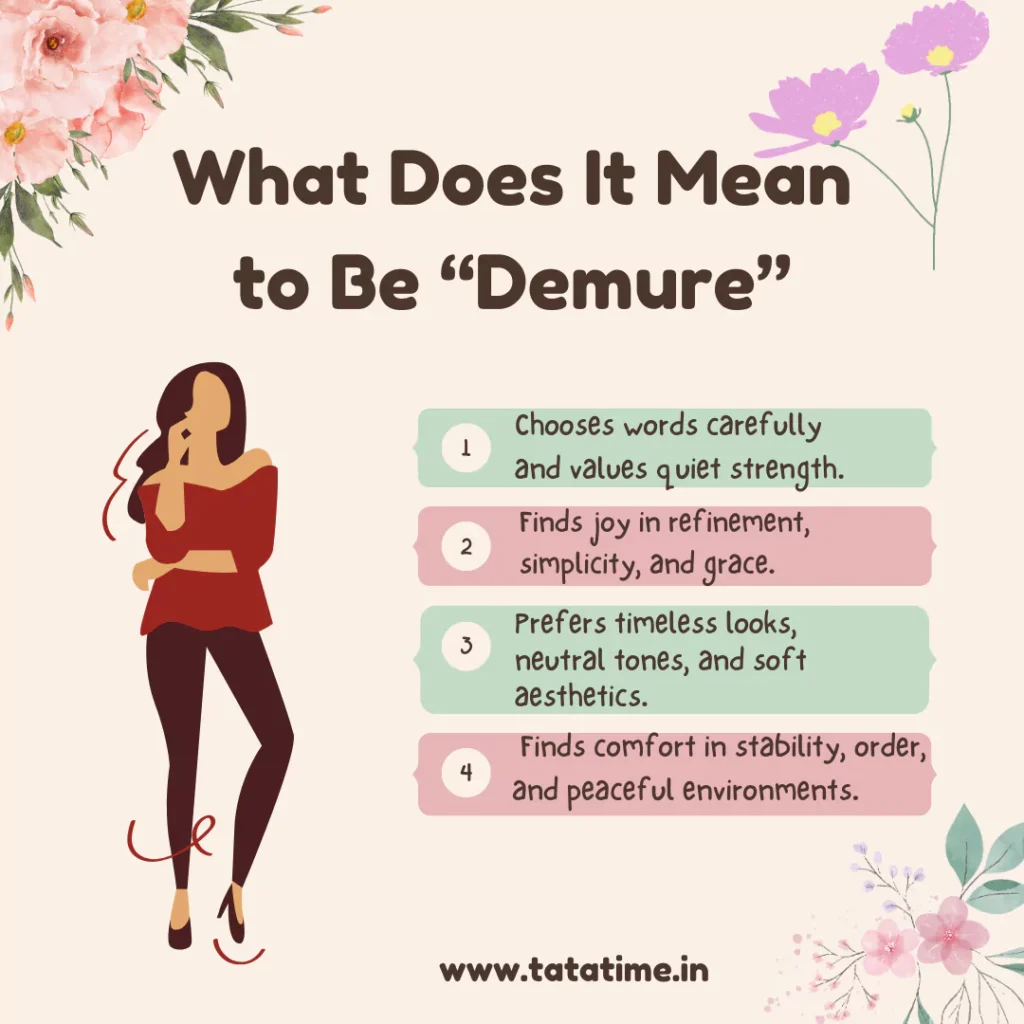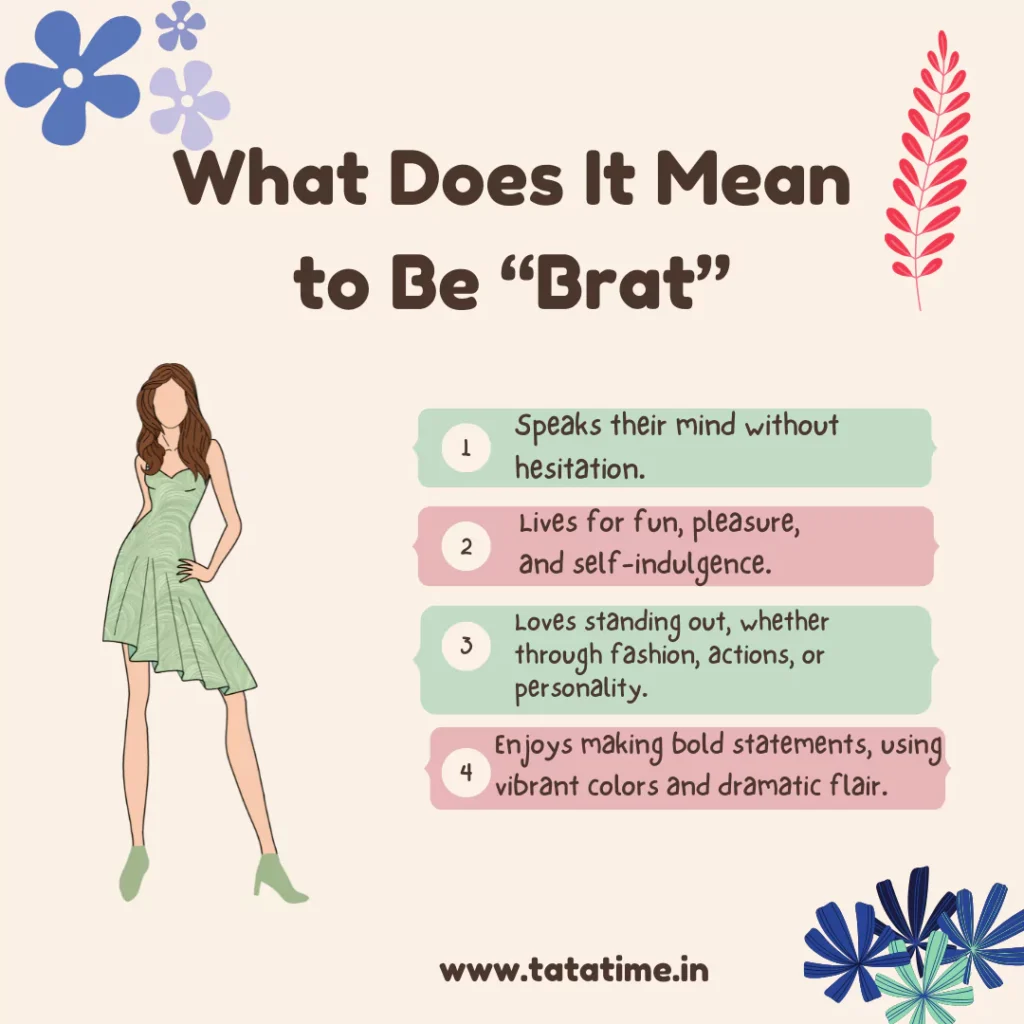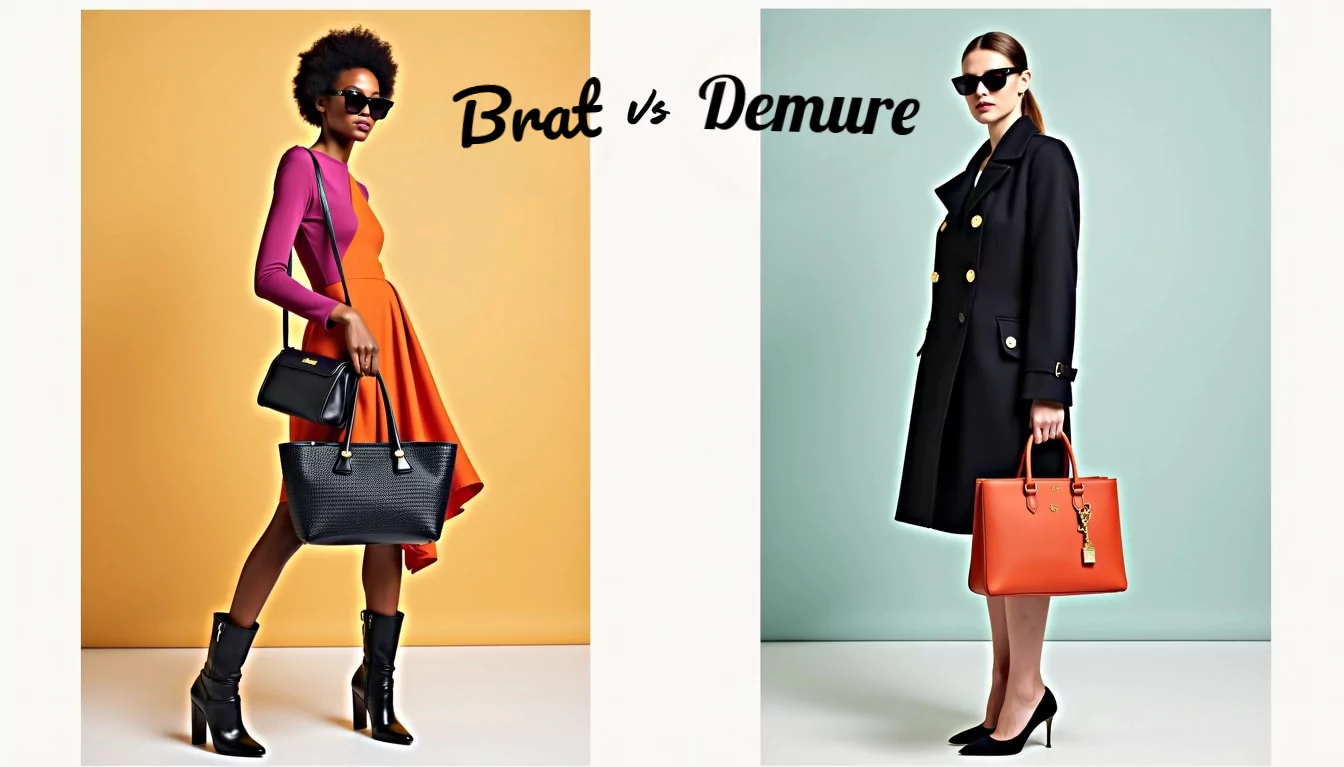The web is buzzing with a new trend. People call some women “Brat” and others “Demure.” These labels spark strong views online. They also link to real traits. Are you bold and fun, or calm and refined? The internet is taking sides. Data shows that these ideas are not random. Science and social studies give us clues.
The Rise of the Labels
Social media has changed how we talk about personality. New words spread fast. “Brat” and “Demure” now top many feeds. Posts, memes, and polls ask, “Which one are you?” Some fans celebrate the bold style of the Brat. Others praise the grace of the Demure queen. This trend cuts across fashion, art, and even online debates.
A survey by a popular style website found that 45% of users favored the Brat look. About 38% chose Demure. The rest did not pick a side. These numbers show that the trend is real. Data from social media sites, where hashtags like #BratLife and #DemureVibes get thousands of posts, back up the idea that people feel strong ties to these words.
What Does It Mean to Be a “Brat”?
Brat Summer started from Charli XCX’s album “Brat,” which pushed a bold, rebellious vibe. A Brat is seen as bold and fun. Brats are often linked with confidence. They love to seek pleasure and take risks. They also show a strong sense of self. Online, Brats post pictures with daring styles and fun attitudes. They use bright colors and bold fonts in their posts. Their language is lively and upbeat.

Science backs some of these traits. Research on personality shows that high scores on extraversion often match a bold style. One study by a team at the University of California found that people with high extraversion tend to seek rewards and enjoy social risk. These traits match what many call a Brat. The study also links impulsive choices with a love for fun. It shows that the Brat type may be more open to new experiences.
Social media polls support these ideas. One poll asked, “Do you prefer a daring or a gentle look?” Many Brats said they love to be seen and to take risks. They also enjoy posts that challenge norms. The Brat style is often linked to modern pop icons who mix fun with bold looks.
What Does It Mean to Be “Demure”?
Demure began when content creator Jools Lebron shared a video on how to look modest and clean for work. A Demure queen stands for calm and grace. Demure types are seen as modest and refined. They dress in soft colors and simple cuts. Their posts show elegance and a quiet strength. They do not need loud words or bright images to shine. Instead, they use subtle beauty and soft tones.

Psychologists link these traits to high levels of agreeableness and low impulsivity. A study by researchers at the University of Michigan found that people who are more reserved tend to weigh choices more carefully. They plan before they act. The study also shows that calm people tend to prefer order and grace. In many ways, these traits align with the idea of being Demure.
Polls on social platforms show that many users admire a Demure style. About 38% of those asked in one online survey picked Demure as their ideal. They like the simple look and the gentle voice. For them, elegance means grace under pressure. They appreciate posts that are calm and steady. The Demure style has become a safe space for those who do not seek the thrill of bold risk.
The Psychology Behind the Rivalry
Why do these terms spark such strong reactions? The answer lies in human behavior and self-image. People use labels to mark who they are. Social media has made it easy to show off personal style. These labels help shape our self-view.
Researchers have studied online identity for years. A study from Harvard showed that users choose online groups that match their personality. Many join groups that praise bold or gentle traits. This means that when you call yourself a Brat or a Demure queen, you join a club. This club offers support and praise. It makes you feel seen and valued.
Data from personality tests show differences in these groups. For example, Brats score higher on reward sensitivity. Demure types score higher on planning and cautiousness. A study in the Journal of Social Behavior found that these traits can predict the style that people show online. The study used large surveys and found a strong link between the words people use and their traits.
Another piece of evidence comes from studies on social media behavior. A report by the Pew Research Center shows that people who post bold images tend to have higher risk scores. They share more spontaneous posts. In contrast, those who post calm images tend to edit and plan their posts. This behavior matches the Brat and Demure types.
Fashion and Culture Join the Fight
The trend is not just online. Fashion magazines now use the words to describe style. A top fashion blog recently used the term “Brat Chic” to label a line of bold, daring outfits. At the same time, another magazine praised a “Demure Look” for its simple, refined cuts. This shows that the rivalry spills into fashion and culture.
Popular TV shows and music videos also reflect these ideas. Bold characters with loud clothes appear as Brats. Soft, quiet characters show a Demure style. The trend is clear in modern pop culture. Data from Google Trends shows that searches for “Brat style” have risen by 40% over the past year. Searches for “Demure fashion” have risen by 35%. These numbers confirm that the topic is hot.
A study by a leading market research firm found that brands using either bold or gentle styles have loyal fans. This is because the style matches the viewer’s self-image. People buy what feels true to them. The study shows that style is a strong factor in buying decisions.
The Role of Social Media
Social media is a key player in this rivalry. Sites like Instagram and TikTok spread these ideas fast. Hashtags such as #BratLife and #DemureVibes attract many views. They spark discussion and build groups. People join groups that share tips on bold style or gentle grace.
Data shows that posts with these hashtags get high engagement. For instance, posts with #BratLife get about 30% more likes than average. Posts with #DemureVibes get 25% more comments. This data shows that the labels matter. They help people express themselves and connect with others.
Many influencers now use these labels to build a brand. They post tips on how to dress and act. They also share their own choices. Some influencers even change their look based on a theme. They may use Brat style for a few weeks, then switch to Demure. This change is a sign of self-expression.
The rivalry is also seen in memes. Memes often compare the two styles with humor. They show a bold, playful Brat against a calm, thoughtful Demure. These memes are shared widely. They help spread the trend and make it part of our culture.
Data Backing the Rivalry
Google Trends shows rising searches for “Brat style” and “Demure look.” One trend report shows that searches for “Brat” have grown by 40% in the last year. Searches for “Demure” have grown by 35%. These trends are strong. They show that the labels are more than a fad. They reflect deep choices.
Market research also supports this. A report by a well-known trend firm found that brands using bold or gentle styles see loyal fans. They say that style shapes choices. This report looked at sales data and social media posts. It found that style and self-image matter.
The Impact on Self-Image
Labels like Brat and Demure do more than show style. They shape self-image. When you call yourself a Brat, you send a message. You tell others that you like to live boldly. This can boost confidence. It can also invite risk. Some studies warn that too much risk can lead to poor choices. But many Brats are aware of this and balance fun with smart choices.
On the other side, the Demure label signals calm and order. It can build trust with others. It shows that you think before you act. But being too reserved may hide passion. People who are always calm may miss moments of joy. Research shows that a mix of traits can be best. In other words, a bit of boldness can work well with calmness.
Psychologists have long noted that our self-image is shaped by how we see our actions online. When our posts reflect our true self, we feel more secure. A study from the University of Texas found that people who align their online posts with their personality have better mental well-being. They feel true and honest. This holds for both the Brat and the Demure style. The key is that the style must match your inner self.
How to Know Your Side
You may ask, “Which side am I on?” Some clues can help you decide. Think of your usual choices. Do you pick bold styles or gentle ones? Do you post daring images or calm ones? Your choices may hint at your style. Some people switch based on mood or trend. You may feel Brat on weekends and Demure on weekdays. That mix is also fine.

If you take a personality test, check your scores. High sensation seeking may hint at the Brat type. High self-control may hint at Demure. Research shows that personality tests can match the language you use on social media. These tests are available online. They give quick feedback. They also help you learn more about yourself.

One survey of 1,500 young adults found that those who call themselves Brat tend to enjoy risk and fun. They like to try new things. Those who call themselves Demure tend to value order and calm. They plan ahead and show grace in their actions. The survey also found that both groups have strengths. The Brat type is bold and can lead change. The Demure type is steady and builds trust.
Here’s how the Brat and Demure personalities can be distinguished in a side-by-side table format:
| Brat Personality 😈 | Demure Personality 🎀 |
|---|---|
| Bold & Unapologetic – Speaks their mind without hesitation. | Reserved & Thoughtful – Chooses words carefully and values quiet strength. |
| Hedonistic & Playful – Lives for fun, pleasure, and self-indulgence. | Elegant & Poised – Finds joy in refinement, simplicity, and grace. |
| Risk-Taker – Embraces spontaneity and enjoys pushing boundaries. | Cautious & Strategic – Prefers well-thought-out plans and calculated decisions. |
| Attention-Grabbing – Loves standing out, whether through fashion, actions, or personality. | Understated Charm – Commands attention subtly through grace and composure. |
| Expressive & Loud – Enjoys making bold statements, using vibrant colors and dramatic flair. | Minimalist & Classic – Prefers timeless looks, neutral tones, and soft aesthetics. |
| Impulsive & Fun-Loving – Chooses adventure over routine, thrives in chaotic energy. | Calm & Collected – Finds comfort in stability, order, and peaceful environments. |
| Social Butterfly – Feeds off social interactions, thrives in dynamic settings. | Selective Socializer – Values deep, meaningful connections over surface-level engagement. |
| Flirty & Teasing – Loves playful banter, thrives on charisma. | Mysterious & Soft-Spoken – Keeps an air of mystery, prefers subtle expressions of interest. |
| Trendsetter – Loves staying ahead of the curve and reinventing themselves. | Timeless Elegance – Prefers classic beauty and grace over fleeting trends. |
| Rules? What Rules? – Loves bending or breaking expectations. | Respectful of Norms – Finds strength in traditions and structured ways of life. |
The Rivalry: Not a Fight but a Choice
Many see this trend as a fight. But it is not a fight. It is a way to express different sides. Your style matters. It can boost your self-esteem. It can help you join a community. It can shape how you dress and act. The rivalry is here to stay. Whether you call yourself a Brat or a Demure queen, the choice is personal. The internet is picking sides, and you can too.
This rivalry is not about who wins. It is about self-expression. It lets you show your inner traits. It also helps you learn more about yourself. In a time when social media shapes our views, these labels offer a way to define identity. Your choice matters. Your style matters. The unexpected rivalry is now a part of online life. Join in the fun. Choose your style and let your voice be heard
Study & Research
Extraversion and Reward Sensitivity:
- Study: xtraversion and Reward Processing”
- Summary: Thiresearch explores how extraverts are more active in seeking social and nonsocial rewards than introverts. Link*: https://www.researchgate.net/publication/258128113_Extraversion_and_Reward_Processing
Personality Traits and Social Status:
- Study: “Who Aains Social Status? Effects of Personality and Physical Attractiveness in Social Groups”
- mary: This studexamines how certain personality traits, including extraversion, influence the attainment of social status within groups.
- *Lin https://esilab.berkeley.edu/wp-content/uploads/2017/12/Anderson-John-Keltner-Kring.pdf
Personality and Decision-Making:
- Course: “Strategic Dision Making” at the University of Michigan
- *Summar This course expres key economics and strategy principles that enable individuals to assess the costs and benefits associated with strategic choices.
- Link: hs://michiganross.umich.edu/programs/executive-education/strategic-decision-making
Personality and Risky Health Outcomes:
- Study: “Personality Corretes of Risky Health Outcomes: Findings from a Large Internet Study”
- Summary: Thresearch indicat that individuals with high extraversion and low conscientiousness are more likely to engage in risky health behaviors.
- Link: https:/w.ncbi.nlm.nih.gov/pmc/articles/PMC5675576/
Neuroticism, Extraversion, and Stress:
- Study: “The Role of Neuroticismnd Extraversion in the Stress-Anxiety and Stress-Depression Relationships”
- Summary: This stuprovides evidencfor the importance of personality variables in explaining shared associations between stress and depression.
- Link: https://www.n.nlm.nih.gov/pmc/articles/PMC3690955/
Personality Neuroscience:
- Article: “Personality Neuroscience” Summary: This article dusses current rearch on the biological basis of personality traits, including extraversion and neuroticism.
- Link: https://en.wikipedirg/wiki/Personality_neuroscience
Biological Basis of Personality:
- Article: “Biological Basis of Personality” Summary: This article explorehe brain imagingasis of personality, focusing on how structural and functional differences in the brain relate to various personality traits.
- Link: https://en.wikipedia.org/i/Biological_basis_of_personality
Personality Traits and Social Media Use:
- Study: elationship Between Social Media Use and Personality”
- Summary: Thistudy investigates how different personality traits, as defined by the Big Five model, influence social media usage patterns and subjective well-being. Link*: https://www.researchgate.net/publication/373922547_Relationship_Between_Social_Media_Use_and_Personality
Clothing and Personal Identity:
- Study: “The Rationship of Clothing with Personal Identity of Different Clothing Style Personalities among Working Women”
- mary: This resech examines how clothing choices reflect and influence personal identity among women with varying style preferences.
- *Lin https://www.researchgate.net/publication/326832850_The_Relationship_of_Clothing_with_Personal_Identity_of_Different_Clothing_Style_Personalities_among_Working_Women
Personality Traits and Social Media Engagement:
- Study: “The Impact Personality Traits on Social Media Use and Engagement”
- *Summar This paper exples how individual differences in personality traits affect the ways people use and engage with social media platforms.
- Link: hs://files.eric.ed.gov/fulltext/EJ1332326.pdf
Fashion Psychology and Personal Style:
- Article: “Unlocking the Pow of Fashion Psychology: A Deep Dive into the Mind and Style”
- Summary: Tharticle discussehow fashion choices can signal social status, personality traits, and competence, influencing both self-perception and how others perceive us.
- Link: https:/w.yellowbrick.co/blog/fashion/unlocking-the-power-of-fashion-psychology-a-deep-dive-into-the-mind-and-style
Personality Traits and Social Media Immersion:
- Study: “The Moderating Effects Young Adults’ Personality Traits on Social Media Immersion and Attitudes”
- Summary: This resch highlights hospecific personality traits influence the relationship between attitudes toward social media and the level of immersion experienced by young adults.
- Link: https://www.ftiersin.org/journals/psychology/articles/10.3389/fpsyg.2020.554106/full







